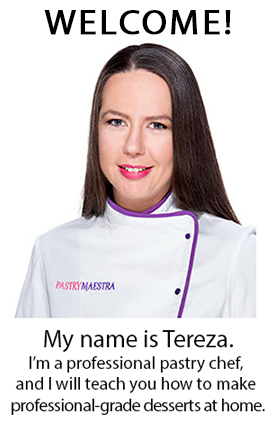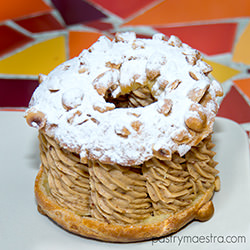
T
here is one boutique I stumbled upon when I was sightseeing (read – searching for pastry shops) through Parisian district Marais that I’ve remembered very well because I have never seen something like that before – it was kind of a pastry shop, but again, it didn’t look like any other pastry shop anywhere! Long story short – it was a boutique of éclairs! Yes, éclairs only, neatly assembled in a display window, in various, vibrant colors, all the same size, all looking tasty and delicious. And the name of the boutique is “L’ Éclair de Génie” (éclair genius when translated from French), owned by the celebrity French pastry chef, the choux master Christophe Adam. When you are in Paris, be sure not to miss this gem! Now, before we continue, let me tell you that éclairs are oblong shaped pastries made of pâte à choux [pɑt a ʃu], or choux pastry. “What the fudge is Pâte à Choux?”, you ask. Well, I’ll teach you now!
What is Pâte à Choux?
Pâte à Choux [pat a ʃu] is unique compared to other pastries because it is first cooked on the stove, and then baked or deep fried. Cooking occurs when the flour is added to the boiling mixture of water, butter, salt, and sugar. That procedure breaks the starch in the flour and thickens the dough. After cooling, the eggs are gradually added to the paste. The quantity of eggs will vary depending on their size and the moisture content in the paste. The finished dough is creamy and smooth. It is baked at 180°C-200°C (350°F-400°F), depending on the oven, which is rather high temperature, so the moisture can evaporate before proteins coagulate. The finished product has golden and crispy skin and is hollow inside. When cooled, it is filled with crème pâtissière or other creams. The most famous pastries made of choux pastry are Éclairs, Paris-Brest, Duchesses or Cream Puffs, Profiteroles, Beignets and churros.
The History of Pâte à Choux
Pâte à Choux was invented in 1540 by Italian pastry chef Popelini (unfortunately, it seems that the poor chef’s first name will remain unknown forever), who was part of the queen Catherina de Medici’s staff and he named his invention “pâte à chaud” or “hot pastry”. Using this “pâte à chaud” he created, at that time very popular, pastry called ‘popelini’. Much later, in 18th century, Chef Avice (also ‘nameless’, just like Popelini), who was pastry chef of the French bishop, politician and diplomat, prince Charles Maurice de Talleyrand-Périgord, improved the recipe and named it pâte à choux, meaning pastry cabbage when translated from French. That is because, when baked, dollops of choux pastry get cracks at the surface and begin to resemble small cabbages. Pâte à choux was perfected in the 19th century by famous chef Antoine Carême (1784-1833) who developed numerous recipes and pastries.
How to Make Pâte à Choux?
- Mix the liquid, butter, sugar and salt in a pan, and bring to a boil.
- Remove from stove and add flour.
- Mix thoroughly and put back on the stove stirring constantly until the dough forms into a ball and dries, which will take approximately 2-3 minutes.
- Transfer to a clean bowl and leave it to cool.
- Beat the eggs and add them gradually to the paste mixing well after each addition.
- The finished dough should be soft, smooth and creamy. You should add just enough eggs to obtain smooth texture, no matter what recipe calls for. The amount of eggs depends on how long did you cook the dough and how much you have dried it out.
- Pipe desired shapes, balls if you want to make profiteroles or cream puffs, oblong shapes for éclairs, rings for Paris-Brest, tear drops for making swans.
- Brush piped choux with egg wash and bake at 180°C-200°C (350°F-400°F) until golden brown.
- Properly baked choux should be golden and crispy on the outside, and hollow and rather dry in the inside. If you see it is too soft and wet inside, take it back to the oven until it is done.
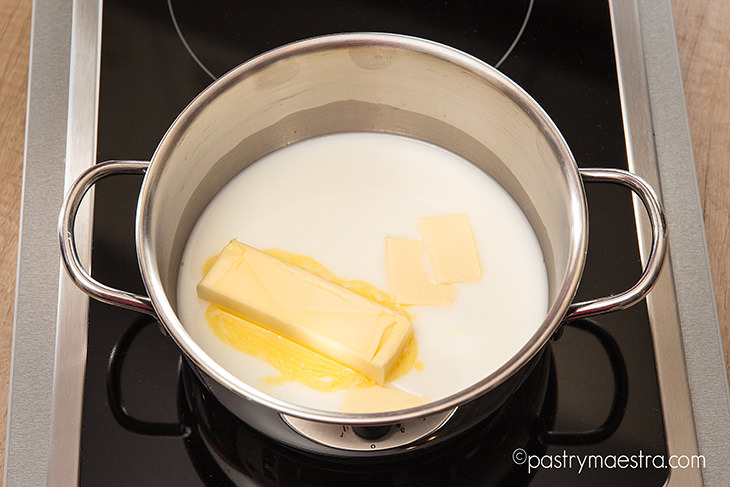
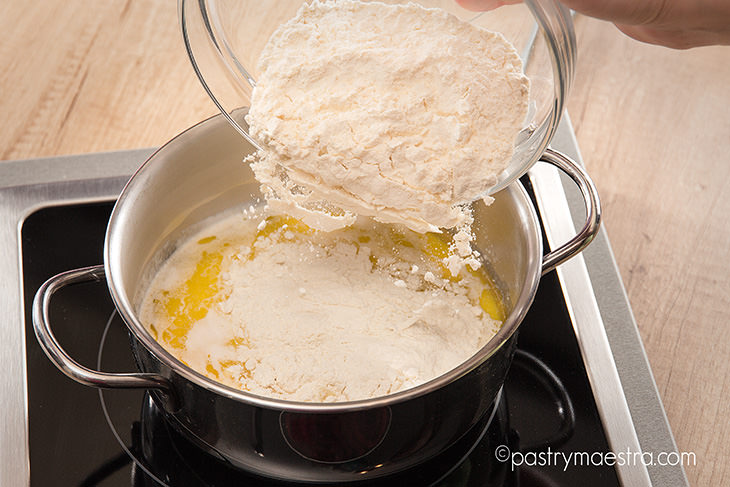
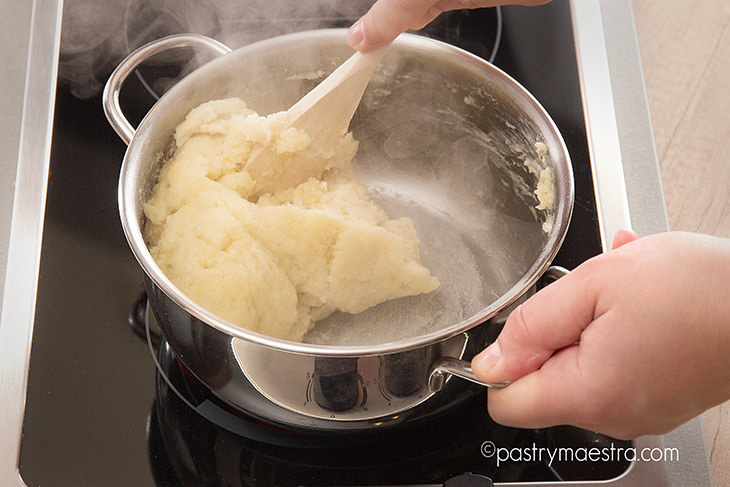

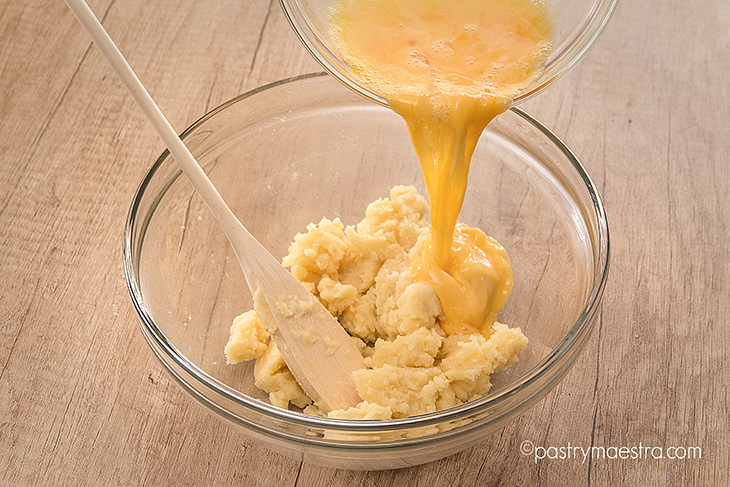
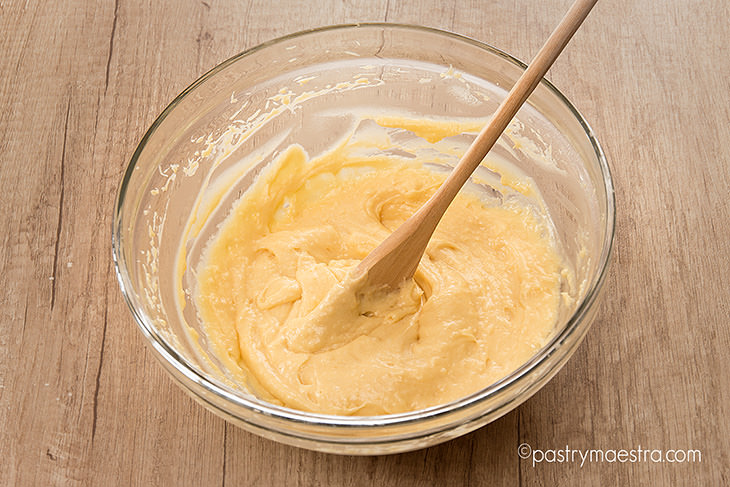
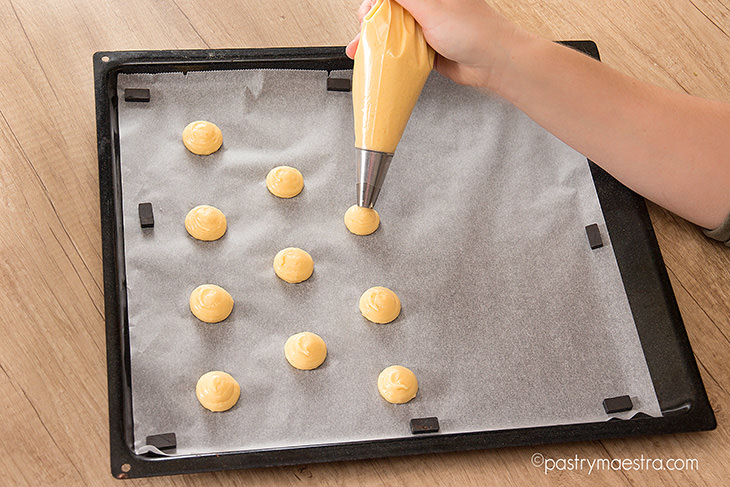
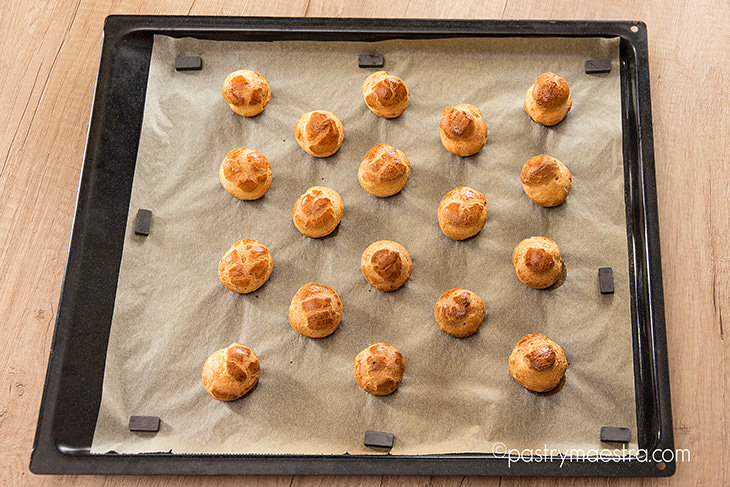
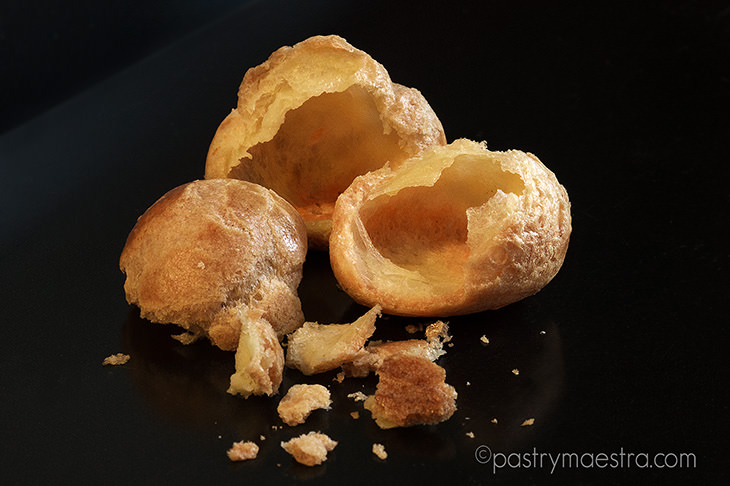
What Can You Make from Pâte à Choux?
Éclairs
Éclairs, (meaning-lightning, if you’ll pardon my French) were created during the 19th century in France. This pastry is an elongated, elegant, lady fingers like shape, that was at first obtained by rolling the pastry by hands into the flour. Before baking, it was sprinkled with almonds. Chef Antoine Carême came to the idea to omit the almonds, cut the éclair horizontally and fill it with apricot jam, chocolate or coffee flavored pastry cream.
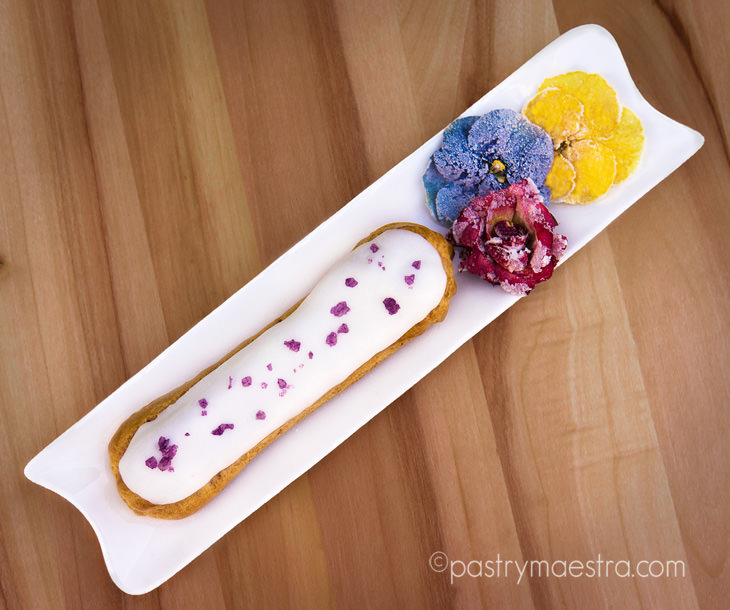
For éclairs, choux is piped into an oblong shape and baked until golden and crisp on the outside and hollow inside. When cold, éclairs’ bottoms are holed with a piping tip, and they are filled with pastry cream and glazed with fondant icing. Traditionally éclairs are flavored with coffee, although today there are countless combinations of different aromas, from simple vanilla and chocolate to exotic passion fruit, mango or lime.
Choux à la crème
Choux à la crème or duchesse are actually cream puffs – baked balls of choux pastry, cut and filled with pastry cream and Chantilly cream, or holed at the bottom, filled with cream and glazed with fondant icing.
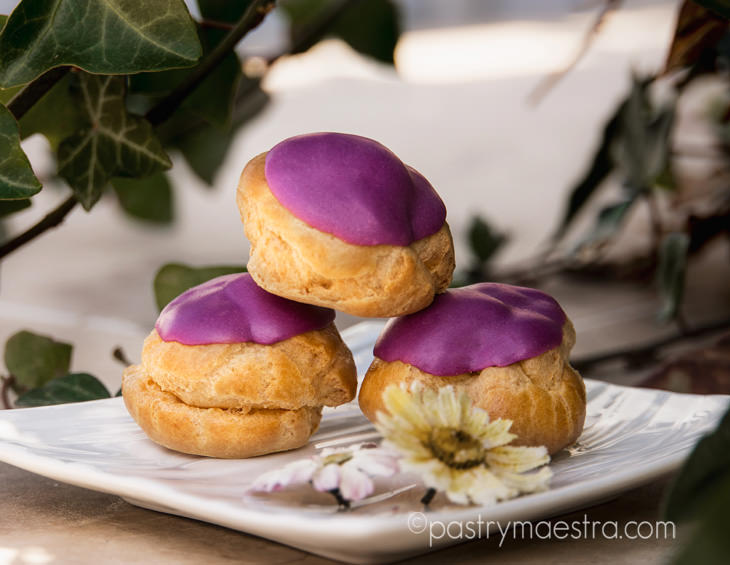
Paris-Brest

Paris-Brest is a ring made of choux pastry, usually filled with hazelnut Crème Mousseline (link). It was designed in 1910 by a pastry chef Louis Durand, who worked at the pastry shop situated on the route of the Paris-Brest bicycle race, and its shape symbolizes the bicycle wheel. The ring, made of choux, is usually topped with nuts before baking, and when cooled, it is cut and filled with Mousseline.
Profiteroles
Profiteroles are small dollops of choux pastry, baked and filled with cream. They are usually served as a plated dessert; however, when neatly stacked and glued together with caramel in the shape of a tall cone, the croquembouche is born!
What is Croquembouche?

Croquembouche is a form of pièce montée (italic) or assembled piece, made of lots of profiteroles dipped in caramel and stacked in a form of a tall cone. Pièce montée is a tall, decorative edible centerpiece made of sugar, marzipan or some other edible material, often decorated with ornaments, created to garnish the table at formal celebrations. Most common form of pièce montée is croquembouche, from croque en bouche meaning ‘crack in the mouth’. It is interesting that this unusual wedding ‘cake’ resembles the most recognizable French structure – the Eiffel Tower. After stacking profiteroles and gluing them with hot caramel, croquembouche is decorated with spun sugar, flowers and sugar coated almonds.
So, if you have never tried to bake cream puffs before, now is the time! Let your imagination fly, create the wildest flavor combination, and, of course, let me know how it went!
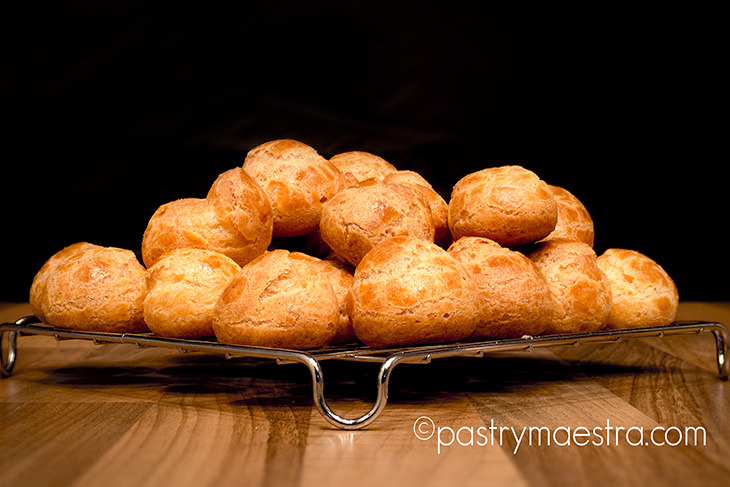
Pâte à Choux Recipe
by:Tereza Alabanda,The Pastry Maestra
PRINT PDF (EN) ISPIŠI PDF (HR)Prep. time : 15 minutes
Cook time : 25 minutes
Ready in 40 minutes
Level : Advanced
Ingredients:- Milk 125g (4.4oz)
- Water 125g (4.4oz)
- Butter 100g (3.5oz)
- Salt 5g (1Tsp)
- Sugar 5g (1Tsp)
- All purpose flour 150g (5.3oz)
- Eggs approximately 250g (8.8oz or 5 medium eggs)
- Put milk, water, butter, salt and sugar in a saucepan and cook until it boils.
- Remove from the stove and add flour.
- Put everything back on the stove and cook, stirring constantly for 2-3 minutes. Transfer the mixture into a bowl of a stand mixer fitted with paddle attachment, and leave it to cool down a bit.
- Mix on medium speed, and gradually add eggs. The finished dough should be soft, smooth and creamy.
- Pipe the desired shape, brush with egg wash and bake at 180°C-200°C (350°F-400°F) until golden brown.
Copyright© PastryMaestra.comTM
Well, what do you think about this post?
Please leave your comment on YouTube, thank you!
I read and really appreciate all the comments, even though I do not always have the time to respond to each one. So – keep me in the loop and try to create some sweetness every day because – Sweetness is happiness!!



